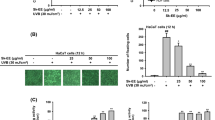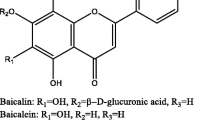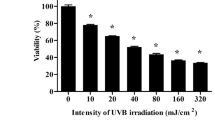Abstract
Exposure of cells to ultraviolet B (UVB) radiation can induce production of free radicals and reactive oxygen species (ROS), which damage cellular components. In addition, these agents can stimulate the expression of matrix metalloproteinase (MMP) and decrease collagen synthesis in human skin cells. In this study, we examined the anti-photoaging effects of extracts of Tetraselmis suecica (W-TS). W-TS showed the strongest scavenging activity against 2,2-difenyl-1-picrylhydrazyl (DPPH) and peroxyl radicals, followed by superoxide anions from the xanthine/xanthine oxidase system. We observed that the levels of both intracellular ROS and lipid peroxidation significantly increased in UVB-irradiated human skin fibroblast cells. Furthermore, the activities of enzymatic antioxidants (e.g., superoxide dismutase) and the levels of non-enzymatic antioxidants (e.g., glutathione) significantly decreased in cells. However, W-TS pretreatment, at the maximum tested concentration, significantly decreased intracellular ROS and malondialdehyde (MDA) levels, and increased superoxide dismutase and glutathione levels in the cells. At this same concentration, W-TS did not show cytotoxicity. Type 1 procollagen and MMP-1 released were quantified using RT-PCR techniques. The results showed that W-TS protected type 1 procollagen against UVBinduced depletion in fibroblast cells in a dose-dependent manner via inhibition of UVB-induced MMP-1. Taken together, the results of the study suggest that W-TS effectively inhibits UVB-induced photoaging in skin fibroblasts by its strong anti-oxidant ability.
Article PDF
Similar content being viewed by others
Avoid common mistakes on your manuscript.
References
Afaq, F. and Mukhtar, H. (2006). Botanical antioxidants in the prevention of photocarcinogenesis and photoaging. Exp. Dermatol., 15, 678–684.
Berson, D.S. (2008). Natural antioxidants. J. Drugs Dermatol., 7, s7–s12.
Brand-Williams, W., Cuvelier, M.E. and Berset, C. (1995). Use of a free radical method to evaluate antioxidant activity. LWTFood Sci. Technol., 28, 25–30.
Brown, M.R. (1991). The amino-acid and sugar composition of 16 species of microalgae used in mariculture. J. Exp. Mar. Biol. Ecol., 145, 79–99.
Brown, M.R. Mular, M., Miller, I., Farmer, C. and Trenerry, C. (1999). The vitamin content of microalgae used in aquaculture. J. Appl. Phycol., 11, 247–255.
Dewinne, A. and Dirinck, P. (1996). Effect of feeding high vitamin E levels on chicken meat quality. J. Agric. Food Chem., 44, 1691–1696.
Ding, B.X. and Wang, C.B. (2003). Inhibitory effect of polypeptides from Chlamys farreri on UVB-induced apoptosis and DNA damage in normal human dermal fibroblasts in vitro. Acta Pharmacol. Sin., 24, 1006–1010.
Fisher, G.J., Datta, S.C., Talwar, H.S., Wang, Z.Q., Varani, J., Kang, S. and Voorhees, J.J. (1996). Molecular basis of suninduced premature skin ageing and retinoid antagonism. Nature, 379, 335–339.
Fisher, G.J., Kang, S., Varani, J., Beta-Csorgo, Z., Wan, Y., Datta, S. and Voorhees, J.J. (2002). Mechanisms of photoaging and chronological skin aging. Arch. Dermatol., 138, 1462–1470.
Fuentes, M.M.R., Fernandez, G.G.A., Perez, J.A.S. and Guerrero, J.L.G. (2000). Biomass nutrient profiles of the microalga Porphyridium cruentum. Food Chem., 70, 345–353.
Gotoh, N. and Niki, E. (1992). Rates of interaction of superoxide with vitamin E, vitamin C and related compounds as measured by chemiluminescence. Biochim. Biophys. Acta, 1115, 201–207.
Guzmán, S., Gato, A. and Calleja, J.M. (2001). Anti-inflammmatory, analgesic and free radical scavenging activities of the marine microalgae Chlorella stigmatophora and Phaeodactylum tricornutum. Phytother. Res., 15, 224–230.
Hafer, K., Iwamoto, K.S. and Schiestl, R.H. (2008). Refinement of the dichlorofluorescein assay for flow cytometric measurement of reactive oxygen species in irradiated and bystander cell populations. Radiat. Res., 169, 460–468.
Kamal-Eldin, A. and Appelqvist, L.A. (1996). The chemistry and antioxidant properties of tocopherols and tocotrienols. Lipids, 31, 671–701.
Katiyar, S.K., Bergamo, B.M., Vyalil, P.K. and Elmets, A.E. (2001). Green tea polyphenols: DNA photodamage and photoimmunology. J. Photochem. Photobiol. B, 65, 109–114.
Kang, S., Chung, J.H., Lee, J.H., Fisher, G.J., Wan, Y.S., Duell, E.A. and Voorhees, J.J. (2003). Topical N-acetyl cysteine and genistein prevent ultraviolet-light-induced signaling that leads to photoaging in human skin in vivo. J. Invest. Dermatol., 120, 835–841.
Kawaguchi, Y., Tanaka, H., Okada, T., Konishi, H., Takahashi, M., Ito, M. and Asai, J. (1996). The effects of ultraviolet A and reactive oxygen species on the mRNA expression of 72-kDa type IV collagenase and its tissue inhibitor in cultured human dermal fibroblasts. Arch. Dermatol. Res., 288, 39–44.
Merwald, H., Klosner, G., Kokesch, C., Der-Petrossian, M., Hönigsmann, H. and Trautinger, F. (2005). UVA-induced oxidative damage and cytotoxicity depend on the mode of exposure. J. Photochem. Photobiol. B, 79, 197–207.
Offord, E.A., Gautier, J.C., Avanti, O., Scaletta, C., Runge, F., Krämer, K. and Applegate, L.A. (2002). Photoprotective potential of lycopene, beta-carotene, vitamin E, vitamin C and carnosic acid in UVA-irradiated human skin fibroblasts. Free Radical Biol. Med., 32, 1293–1303.
Sies, H. and de Groot, H. (1992). Role of reactive oxygen species in cell toxicity. Toxicol. Lett., 64, 547–551.
Punnonen, K., Autio, P., Kiistala, U. and Ahotupa, M. (1991). In vivo effects of solar simulated ultraviolet irradiation on antioxidant enzymes and lipid peroxidation in human epidermis. Br. J. Dermatol., 125, 18–20.
Tomaino, A., Cristani, M., Cimino, F., Speciale, A., Trombetta, D., Bonina, F. and Saija, A. (2006). In vitro protective effect of a Jacquez grapes wine extract on UVB-induced skin damage. Toxicol. In Vitro, 20, 1395–1402.
Valkonen, M. and Kuusi, T. (1997). Spectrophotometric assay for total peroxyl radical-trapping antioxidant potential in human serum. J. Lipid Res., 38, 823–833.
Varani, J., Warner, R.L., Gharaee-Kermani, M., Phan, S.H., Kang, S., Chung, J.H., Wang, Z.Q., Datta, S.C., Fisher, G.J. and Voorhees, J.J. (2000). Vitamin A antagonizes decreased cell growth and elevated collagen-degrading matrix metalloproteinases and stimulates collagen accumulation in naturally aged human skin. J. Invest. Dermatol., 114, 480–486.
Varani, J., Perone, P., Fligiel, S.E., Fisher, G.J. and Voorhees, J.J. (2002). Inhibition of type I procollagen production in photodamage: correlation between presence of high molecular weight collagen fragments and reduced procollagen synthesis. J. Invest. Dermatol, 119, 122–129.
Vincenti, M.P. and Brinckerhoff, C.E. (2002). Transcriptional regulation of collagenase (MMP-1, MMP-13) genes in arthritis: Integration of complex signaling pathways for the recruitment of gene-specific transcription factors. Arthritis Res., 4, 157–164.
Widmer, R., Ziaja, I. and Grune, T. (2006). Protein oxidation and degradation during aging: Role in skin aging and neurodegeneration. Free Radical Res., 40, 1259–1268.
Author information
Authors and Affiliations
Corresponding authors
Rights and permissions
This is an Open-Access article distributed under the terms of the Creative Commons Attribution Non-Commercial License (https://doi.org/creativecommons.org/licenses/by/3.0/) which permits unrestricted non-commercial use, distribution, and reproduction in any medium, provided the original work is properly cited.
About this article
Cite this article
Jo, W.S., Yang, K.M., Park, H.S. et al. Effect of Microalgal Extracts of Tetraselmis suecica against UVB-Induced Photoaging in Human Skin Fibroblasts. Toxicol Res. 28, 241–248 (2012). https://doi.org/10.5487/TR.2012.28.4.241
Received:
Revised:
Accepted:
Published:
Issue Date:
DOI: https://doi.org/10.5487/TR.2012.28.4.241




